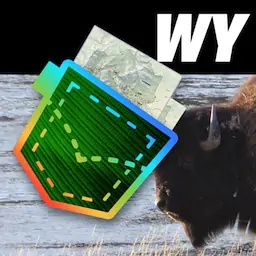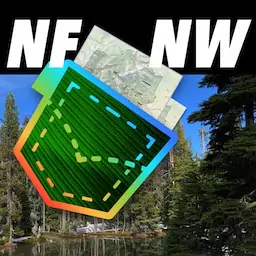Black Elk Wilderness & Norbeck Wildlife Preserve Brochure FrontBlack Hills |
Brochure of Black Elk Wilderness & Norbeck Wildlife Preserve and its trail system. Published by the U.S. National Forest Service
featured in
| Wyoming Pocket Maps |  | |
| National Forests Northwest |  |
"Keep close to Nature's heart, yourself; and break clear away once in awhile, and climb a mountain or spend a week in the woods.
Wash your spirit clean." ~John Muir
Trail #9 from Sylvan Lake to Black Elk
Peak is heavily used from May 1 through
September 30. If you are looking for
solitude, please consider one of our less
traveled trails.
The Norbeck Wildlife Preserve was
established in 1920 for the "protection
of game animals and birds and to be a
breeding place therefor." Elk, deer,
mountain goats, turkeys, and mountain
lions make their home amid the rugged
granite peaks and small streams.
This area has a rich mining history,
and you may encounter old cabin
remains or mine workings. One gold
deposit supported two stamp mills
($5 million value of gold at today's
prices). Never enter an aboandoned
mine - they are often very unsafe.
The Black Elk Wilderness lies in the
center of the Norbeck Wildlife
Preserve, and in the heart of the
Black Hills. Named for Black Elk, an
Oglala Lakota holy man, the area is
characterized by massive granite
outcroppings, pungent pine, and
scenic vistas across the hills. Originally
established by Congress in 1980, it was
increased in size to its current 13,426
acres in 2002.
Black Elk Peak was named after Black
Elk, an Oglala Lakota holy man, in
2016. The Civilian Conservation Corps
constructed a stone tower in 1938 that
served as a fire lookout until 1967. In
1982, the tower, dam, and pump
house were placed on the National
Register of Historic Places because of
their historic significance.
Nearly everyone has a special place
somewhere in the outdoors.
Many have found it in the
central Black Hills, within the
Norbeck Wildlife Preserve
and the Black Elk Wilderness.
Special Places in the Heart of the Black Hills National Forest
What To Know Before You Go
Only primitive,
non-mechanized methods
of transportation are
allowed in the Black Elk
Wilderness. Items such
as bicycles, strollers,
chainsaws, handcarts,
and hang gliders
are prohibited.
To reduce conflicts
with wildlife and
other visitors, pets
must be leashed
or under strict
voice control.
1/4 mile from
Black Elk Peak
and Trail #9.
To minimize
congestion and
enhance wilderness
solitude, goup size
is limited to 25
people and
stock combined.
Horses must use
certified weed
and seed-free hay
and pellets. Scatter
manure before
you leave. Use
highlines or
hobbles to tie up
stock, at least 100
feet from water.
Leave No Trace
When visitors leave evidence of
their journeys, the next visitor
loses the sense of solitude and
undisturbed wildness. Skilled
wilderness users take responsibility
for leaving no trace of
their visit.
To keep our water
pure, do not camp or
dispose of human
waste within 100 feet
of streams or other
water sources.
100 feet
from water
Camping is allowed
anywhere EXCEPT
within 1/4 mile from
Black Elk Peak and
Trail #9.
Black Elk
Wilderness
Self Registration
" Walk softly.
Earth receives foot and paw,
hoof and claw with equal grace.
But it is the way of the wild not
to overstep the bounds of
hospitality. This is a wild place.
Follow me; walk softly and
Open
leave no trace that rain and
fires are
snow cannot erase."
prohibited.
Bring a camp
~Elise Maclay
stove.
Visitors to the Black Elk Wilderness
must fill out a Use Registration
Form, available at any of the major
trailhead portals into the
Wilderness. The Registration Form
provides the Black Hills National
Forest with important visitor use
information. In addition, the form
asks for the visitor's commitment
to abide by the wilderness
regulations, ensuring that visitors
"leave no trace" of their visit.
General Information
Thank you for being a responsible
user of your national forest!
Location Map
To
Lead-Deadwood
385
Trail Ethics
Cutting switchbacks causes
erosion. Please stay to the
designated trail.
Sheridan
Lake
To
Rapid City
16
Hill City
Mt. Rushmore
National Memorial
Black Elk Wilderness
and
Norbeck Wildlife
Preserve
16A
Trail System
Keystone
244
Extreme Weather
Clear sunny days can quickly turn
into afternoon thunderstorms.
Carry extra warm clothes, and be
prepared for snow or hail!
87
Black Elk
Wilderness
385
16
16A
87
Norbeck Wildlife
Preserve
89
16A
Water
Streams in the forest may look
safe to drink, but usually it is
not. Carry at least one quart of
water per hiker.
Fires
Open fires are prohibited
throughout the forest at all times.
Bicycles and Motors
Unless otherwise noted, the trails
shown in this brochure are open
for hikers and stock users only.
Expect and respect
other trail users.
16
36
16A
To
Hermosa
Custer
Custer
State Park
87
To
Hot Springs
To
Newcastle
More Information:
Supervisor’s Office and
Hell Canyon Ranger District
1019 N. 5th St., Custer, SD 57730
(605) 673-9200
www.fs.usda.gov/blackhills
www.fs.usda.gov/recmain/blackhills/
recreation
Black Hills
USDA is an equal opportunity provider and employer. 2016


